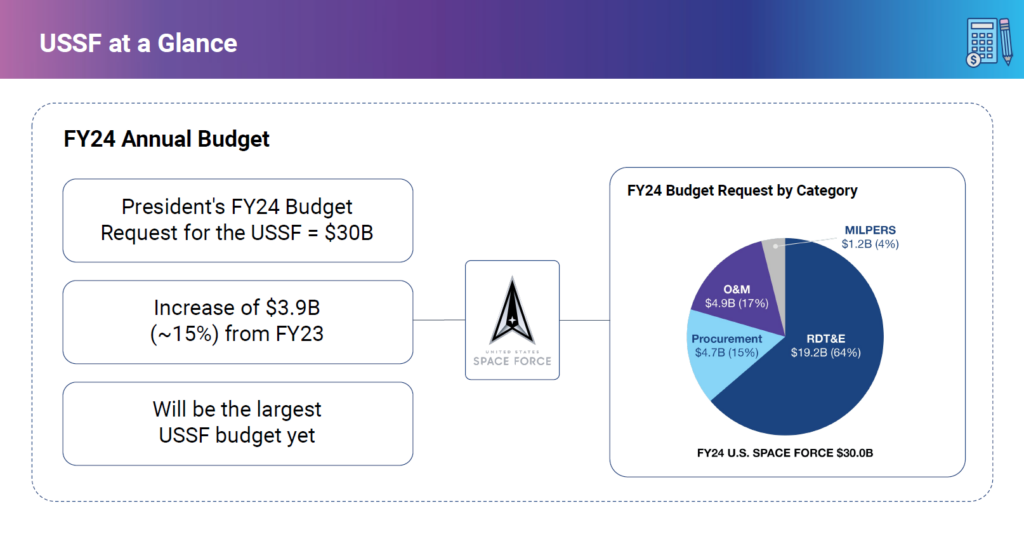 The US Space Force (USSF) received a substantial boost in its 2024 budget, securing a significant 15% increase compared to Fiscal Year 2023. This $30 billion budget empowers the USSF to address multiple crucial priorities. GPS, communications, and missile tracking are all part of the massive budget with the top three having specific focuses on Low Earth Orbit operations and the capability to bring these satellites to orbit.
The US Space Force (USSF) received a substantial boost in its 2024 budget, securing a significant 15% increase compared to Fiscal Year 2023. This $30 billion budget empowers the USSF to address multiple crucial priorities. GPS, communications, and missile tracking are all part of the massive budget with the top three having specific focuses on Low Earth Orbit operations and the capability to bring these satellites to orbit.
At a recent Washington Technology Power Breakfast event, the top three areas of focus were broken down:
National Security Space Launch: Originally known as the Evolved Expendable Launch Vehicle (EELV) program, the National Security Space Launch (NSSL) program reflects reusability in launching U.S. government payloads. Current launch vehicles used in this program include United Launch Alliance’s Delta IV Heavy and Atlas V (Expendable) along with SpaceX’s Falcon 9 and Falcon Heavy (Reusable). ULA’s Vulcan will replace Delta IV Heavy and Atlas V in the near term.
The latest Phase of this program is Phase 3 which will expand the pool of launch vehicles (rockets). This phase has two “lanes”, Lane 1 is for less demanding launches and is geared for newer launch providers. Lane 2 is for more demanding launches and is geared toward heavy-lift providers (likely legacy companies).
Space Technology Development and Prototyping (Transport Layer): Within this line item lies Transport, which is by far the most heavily funded portion of the total program element. The so-called Transport Layer will operate in Low Earth Orbit (LEO) and provide “a resilient and unified military data transport layer, sensor capabilities, and alternate position, navigation, and timing (APNT) capabilities enabled by a proliferated Low Earth Orbit (pLEO) architecture”.
Contracts for Tranche 0-2 have been awarded York Space Systems, Lockheed Martin and Northrop Grumman. Tranche 0 satellites have all recently launched. Tranche 3 architecture and capabilities needed by the Space Development Agency (SDA) are currently under discussion. Tranche 3 will likely launch in the 2028/29 timeframe.
Multiple Line Items (Tracking Layer, OPIR GEO & Polar, MEO layers): Missile tracking is a large portion of the top line items in the FY24 budget request. There are many aspects to this future Proliferated Warfighter Space Architecture (PWSA) in LEO and satellites in higher orbit (Medium Earth Orbit (MEO) and Geostationary Orbit). To track missiles in the future, the SBIRS High successor OPIR (Overhead Persistent Infrared) will operate in both GEO, to be built by Lockheed Martin and Polar orbits by Northrop Grumman.
The LEO portion, known as the Tracking Layer, will be developed in Tranches similar to the Transport Layer. SpaceX, Northrop Grumman, Raytheon, L3Harris, Lockheed Martin and Sierra Space will build these satellites. Tranche 3 is currently being investigated by the SDA.
The MEO portion of the total tracking system, the Medium Earth Orbit (MEO) Missile Warning and Tracking (MW/MT) satellites, will come in “epochs” much like tranches (i.e. Epoch 1, Epoch 2 & Epoch 3). Millennium Space, a Boeing subsidiary, will build six of the reported nine Epoch 1 satellites. Epoch 2 contracts have yet to be issued but combined there will be nine Epoch 1 satellites and 18 Epoch 2, with Epoch 3 being 9 satellites replacing Epoch 1.
Final Thoughts
Overall, the US Space Force’s $30 billion budget prioritizes resilience across its programs, particularly for communications and tracking capabilities. This translates to a “more-satellites-are-better” approach, aiming to enhance survivability in case of threats. However, the critical equation goes beyond just building satellites – delivering them to orbit becomes equally crucial.
The budget recognizes this by allocating resources to bolster launch vehicle capabilities. Investing in next-generation launchers and expanding launch infrastructure ensures these resilient satellites reach their designated positions, maximizing their value and safeguarding vital space assets.
In essence, the budget acknowledges that both building and deploying resilient satellites are fundamental to securing US dominance in space. It’s a two-pronged approach, where robust spacecraft work hand-in-hand with reliable launch systems to achieve true spacepower resilience.
Ready to take advantage of the USSF budget surge? Get ahead of the market — and your competition — with Forecast International’s Space Systems Library.
Carter Palmer has long held a keen interest in military matters and aviation. As an analyst for Industrial & Marine Turbine Forecast, Carter specializes in examining key gas turbine programs for electrical power generation, mechanical drive, and marine propulsion applications. He is also responsible for updating the reports and analyses within the Space Systems Forecast – Launch Vehicles & Manned Platforms and Space Systems Forecast – Satellites & Spacecraft products.




